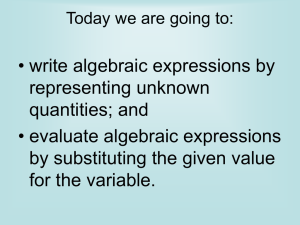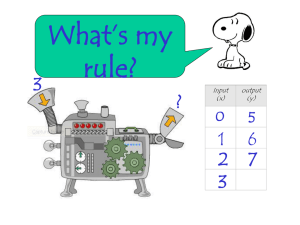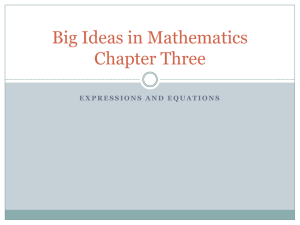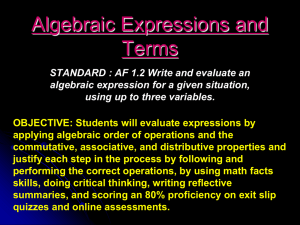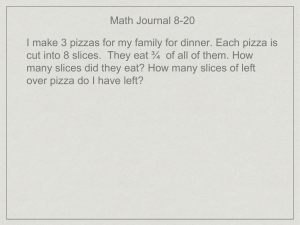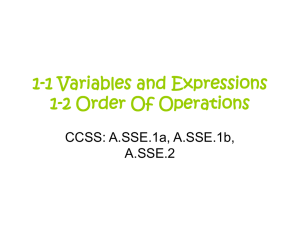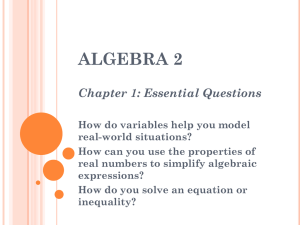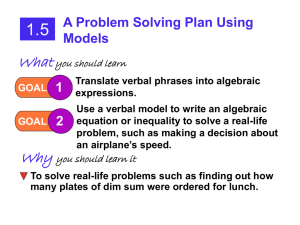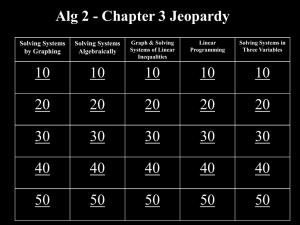12753
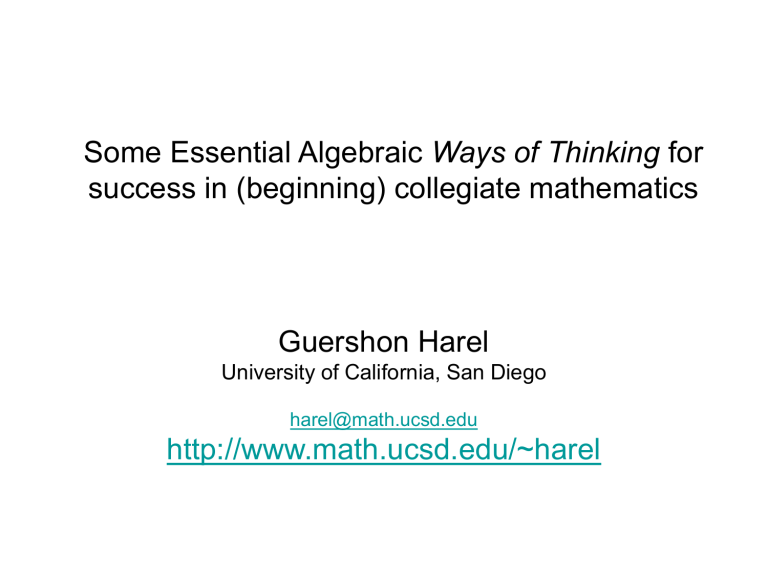
Some Essential Algebraic Ways of Thinking for success in (beginning) collegiate mathematics
Guershon Harel
University of California, San Diego harel@math.ucsd.edu
http://www.math.ucsd.edu/~harel
Piaget, J., Inhelder, B., & Szeminska, A. (1960). The Child’s
Conception of Geometry .
“As often happens in psycho-genetic development, a mental operation is deceptively simple when it has reached its final equilibrium, but its genesis is very much more complex.”
Some Essential Algebraic Ways of Thinking for success in (beginning) collegiate mathematics
1. Thinking in terms of functions
2. Representing concepts, statements, and problems algebraically
3. Symbolic manipulation skill
4. Structural reasoning
5. Expressing algebraically ALL the problem constraints
6. Definitional reasoning
7. Geometric thinking
Some Essential Algebraic Ways of
Thinking
1. Thinking in terms of functions
Jack and Jill run 10 kilometers. They start at the same point, run 5 kilometers up a hill, and return to the starting point by the same route. Jack has a 10 minute head-start and runs at the rate of 15 km/hr uphill and 20 km/hr downhill. Jill runs 16 km/hr uphill and 22 km/hr downhill. How far from the top of the hill are they meet?
What is the distance between Jack and Jill at any given moment from the time Jill leaves until Jack arrives?
Some Essential Algebraic Ways of
Thinking
2. Representing concepts, statements, and problems algebraically
• v is in the span of u
1 and u
2
• c is an eigen value of A
• u
1 and u
2 are linearly independent
• The parabola is a symmetric figure
• If the second differences of a pattern are constant, then the pattern is quadratic
Some Essential Algebraic Ways of
Thinking
3. Symbolic manipulation skill
Algebraic invariance
Algebraic invariance is the way of thinking where one recognizes that algebraic expressions are manipulated not haphazardly but with the purpose of forming a desired structure while maintaining certain properties of the expression invariant.
ax
2 bx
0 ( a
0) ( x
T )
2
L
0.14 12.91 14 1291
12.91
0.14
12.91 100
1291
14
Proportional reasoning
Understanding decimals
tan
1 du u
Some Essential Algebraic Ways of
Thinking
4. Structural reasoning operative thought (Piaget)
The set of the common points between a line and a conic section is either empty, consists of one point, or consists of two points.
h lim
0
( x
h ) n x n h
Is there a number larger than each term of the
2
1.41421
2
2
2
1. 8478
2
2
2
2
1. 9616
2
Therefore
Every term in the
sequence is less than 2.
2 is less than 2
Therefore
2
2 is less than 4
Therefore
2
2 is less than 2
Therefore
Therefore
2
2
2 is less than 4
2
2
2 is less than 2
Some Essential Algebraic Ways of
Thinking
5. Referential symbolic reasoning
Non-referential symbolic reasoning refers to the behavior of operating on symbols as if they possess a life of their own, not as representations of entities in a coherent reality
With this way of thinking, one does not attend to meaning.
Some Essential Algebraic Ways of
Thinking
• Non-referential symbolic reasoning
(loga+logb)/logc=(a+b)/c
Row reduction preserves row-space
Row reduction preserves column-space
(x,y) on C1 transformed into (x+a,y) on C2.
If C1: y=f(x), then C2: y=f(x+a)
Some Essential Algebraic Ways of
Thinking
6. Expressing algebraically ALL the problem constraints
Rectangular Land Problem
A farmer owns a rectangular piece of land. The land is divided into four rectangular pieces, known as Region A,
Region B, Region C, and Region D, as in the figure:
C A
B
D
One day the farmer’s daughter, Nancy, asked him, what is the area of our land? The father replied:
I will only tell you that the area of Region B is 200 m 2 larger than the area of Region A; the area of Region C is 400 m 2 larger than the area of Region B; and the area of Region D is
800 m 2 larger than area of Region C.
What answer to her question will Nancy derive from her father’s statement?
Students’ Responses
All students translated the farmer statement into a system equations similar to:
B A 200
C B
D C
400
800
Attempted to construct a 4th equation, e.g.,
( A
B
C
800)
Teacher’s action 5:
Reflective public discussion:
• Why did our first approach to solving the problem fail?
• The need to attend to the figure’s form:
C A
B
D versus
D
A
C
B
Objective 2:
• To advance the way of thinking:
In representing a problem algebraically, all of the problem constraints must be represented.
Some Essential Algebraic Ways of
Thinking
7. Definitional reasoning
• Definitions in terms of students’ (immediate) experience
Some Essential Algebraic Ways of
Thinking
8. Relating p hysical reality to a lgebraic reality to g eometric reality
• GPA way of thinking
Some Essential Algebraic Ways of
Thinking
9. Geometric thinking
The loss of geometry


